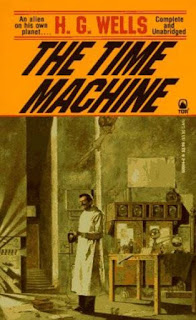Stories of time
travel have occupied a prominent place in speculative fiction since the success
of H. G. Wells’ The Time Machine in
1895. Since its publication, people have travelled to various historical eras,
engaged in adventures, changed the past, and dealt with some of the problems
and dangers of altering what has happened in the space-time continuum. In the Star Trek episode, “The City on the Edge
of Forever,” Dr. McCoy alters the time line so that, the talking time machine
called The Guardian of Forever, tells them “nothing you know exists.” Kirk and
Spock go back to America during the Great Depression in order to correct the
problem. In the sixties, I watched a sappy TV show called The Time Tunnel. I only remember an episode
where Niccolo Machiavelli got
into the famed tunnel and was helping the Confederates win the Battle of
Gettysburg. A new television show, Timeless,
with a similar plot construct, premiered this year.
 |
| City on the Edge of Forever |
Time intrigue us. We wonder if its limits could be defied—or if
they ever have been defied. One sub-genre of time-travel writing involves
speculation on how perhaps time travelers brought knowledge of technology from their
own era and facilitated innovations that advanced civilization. My story “Sennacherib”
borders on this slant. The characters in it do not introduce any new technology
to the ancient world, but they do use modern technology to cause an event to
happen.
The story begins
when a British army unit fighting in the Middle East during World War I is
engulfed by a sandstorm. They hunker down until it ends and move on toward a
rendezvous point with another unit only to find the unit is not there and that the
roads and the terrain, as described in the maps they have, seems altered.
They have lost radio contact with headquarters. And, at night, Captain Rupert,
the unit commander notices the sky looks different. He sees one of his soldiers
who knows the stars well enough to navigate by them and speaks with him:
“Giles, are we where we are supposed to be?”
he asked.
Giles, who knew
the stars from years as a sailor, looked up.
“Well, I think so.
But the stars aren’t right.”
Rupert laughed.
“Not right? How could they be not right?”
“They’re at odd
angles. They seem to have shifted. I’ve been noting their exact positions in
case we get lost so we can find our way back. Tonight they look off by good
distances. I feel like I’m looking at what Ptolemy might have seen—or someone
before him. The most startling thing is that the star Thuban, which is part of
the constellation Draco, is where Polaris, the North Star, ought to be. I’ve
never seen the sky look exactly like this.”
The next day the
come to a destroyed village and are appalled at the brutality whose aftermath
they encounter. People have been skinned alive, impaled on spears, women and
children murdered. The British fought mostly the Ottoman Turks in the Middle
East in World War II and while Rupert and his men know the Turks could be
brutal, they had never seen them do anything as horrible as this. Later they
are attacked—not by the Germans or the Turks, but by an army dressed in ancient
garments, holding shields, and carrying spears.
With modern
weapons at their disposal, the British are able to destroy the force attacking
them. With all the evidence around them, they realize they have gone back in
time and are in the era of the Assyrian army. They have landed in the days of
the brutal king Sennacherib, who attempted to conquer Jerusalem.
Determined to
play their cards as best they can, they move toward the besieged city of
Jerusalem and find it surrounded by the Assyrian army. They know from the
biblical account that Sennacherib’s army perished, but Rupert decides he wants
to do his part to save Jerusalem from the fate of the village they passed by on
their way there.
Rupert’s unit
had been on a mission to deliver gas shells. They decide to use them on the
Assyrians and are able to launch them from a concealed area so the guns firing
them off cannot be heard. The shells explode in the soft earth ramparts the
Hebrews have set up to defend their city. The wind carries the poison gas in
invisible clouds over the Assyrian army, destroying it. Rupert and his men
sleep. When they wake up they once more have radio contact with their
compatriots and are informed that General Allenby has taken Jerusalem and the
Ottoman forces have retreated south. Their stock of spent gas shells is
miraculously replenished. They realize they have been a part of history—a history
they have already read.
“Sennacherib”
appeared in Stupefying Stories and was represented in Five Stars, an anthology
of some of the earlier stories in that magazine. Get a copy here.
For a great Christmas gift to those who read, and who like vampire novels, check out Sinfonia: The First Notes on the Lute, A Vampire Chronicle, Part One.
For additional titles, see my Writer's Page.
I would love to hear your comments.

















